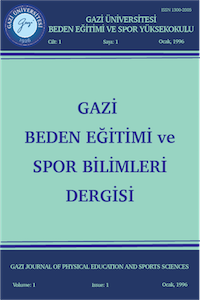Abstract
Bu çalışmanın
amacı, lise birinci sınıf öğrencilerinin beden eğitimine yönelik tutumlarını
belirlemek ve atletik yeterlik düzeyinin ve cinsiyetin beden eğitimine yönelik
tutum üzerine etkisini incelemektir. Çalışmaya 312 kız (X yaş =
14.96 ± 0.34) ve 318 erkek öğrenci (X yaş = 14.96 ± 0.36)
katılmıştır. Çalışmaya katılanların beden eğitimine yönelik tutumlarını ve
atletik yeterlik düzeylerini belirlemek amacıyla "Beden Eğitimi ve Spor
Tutum Ölçeği (BESTO)" ve "Harter Gençler için Kendini Algılama
Envanteri"’nin beş maddeden oluşan atletik yeterlik alt ölçeği
kullanılmıştır. 2 X 2 (Cinsiyet, Kız/Erkek X Grup, Yüksek Atletik
Yeterlik/Düşük Atletik Yeterlik) iki yönlü varyans analizi (ANOVA) sonuçları,
beden eğitimine yönelik tutum puanlarının cinsiyete göre farklılaştığını (F(1,626)
= 6.21; p<.05) ve erkeklerin beden eğitimine yönelik tutumlarının kızlardan
daha yüksek olduğunu ortaya koymuştur. Öte yandan, ANOVA sonuçları, beden
eğitimine yönelik tutum puanlarının grup etkisinin (F(1,626) = 1.24;
p>.05) ve cinsiyet x grup etkileşiminin (F(1,626) = 0.14;
p>.05) anlamlı olmadığını göstermiştir. Bulgular, lise birinci sınıf erkek
öğrencilerin beden eğitimine yönelik tutumlarının kız öğrencilere göre daha olumlu
olduğunu gösterirken, atletik yeterliğin yüksek ya da düşük olmasının
öğrencilerin beden eğitimine yönelik tutumları üzerinde anlamlı bir etkiye
sahip olmadığını da ortaya koymaktadır.
Keywords
References
- 1. Anderssen, N. (1993). Perception of Physical Education Classes Among Young Adolescents: Do Physical Education Classes Provide Equal Opportunities to All Students? Health Education Research, 8 (2), 167-79.
- 2. Bedir, L., & Mirzeo¤lu, N. (2000). Researching of the Effect of Teachers of Physical Education in High Schools and Equal Ones in Directing the Students for the Extra. 6th Sport Sciences Congress, November, 3-5, Ankara, Turkey.
- 3. Biddle, S. & Armstrong, N. (1992). Children’s Physical Activity: An Explatory Study of Psychological Correlates. Social Science Medicine, 34, 311-325.
- 4. Birtwistle, G. E., & Brodie, D. A. (1991). Children’s Attitudes Towards Activity and Perceptions of Physical Education. Health Education Research, 6, 4, 465-478.
- 5. Brustad, R. (1993). Who Will Go Out and Play? Parental and Psychological Influences on Children’s Attraction to Physical Activity. Pediatric Exercise Science, 5, 210-223.
Abstract
The purpose of this study was to determine attitudes of 9th grade
students in high school toward physical education and to investigate the effect
of athletic competence and gender on attitudes toward physical education. In
this study 312 girls (M age = 14.96 ± 0.34) and 318 boys (M age = 14.96 ± 0.36)
were participated. "Attitudes Toward Physical Education and Sport"
and "Harter Self-Perception Profiles for Adolescents" were
administered to assess attitudes toward physical education and athletic
competence of participants respectively. The results of 2 X 2 (Gender,
Females/Males X Group, High Athletic Competence/ Low Athletic Competence)
univariate analysis of variance (ANOVA) showed that there was a significant
difference in attitudes toward physical education with regard to gender (F(1,626)
= 6.21; p<.05) and males had higher score than females. In addition ANOVA
results demonstrated that there was no significant main effect of group (F(1,626)
= 1.24; p>.05) and group by gender interaction (F(1,626) = 0.14; p>.05)
on attitudes toward physical education. The findings of this study indicated
that boys had more positives attitudes toward physical education than girls.
Besides, athletic competence had no significant effect on students’ attitudes
toward physical education.
References
- 1. Anderssen, N. (1993). Perception of Physical Education Classes Among Young Adolescents: Do Physical Education Classes Provide Equal Opportunities to All Students? Health Education Research, 8 (2), 167-79.
- 2. Bedir, L., & Mirzeo¤lu, N. (2000). Researching of the Effect of Teachers of Physical Education in High Schools and Equal Ones in Directing the Students for the Extra. 6th Sport Sciences Congress, November, 3-5, Ankara, Turkey.
- 3. Biddle, S. & Armstrong, N. (1992). Children’s Physical Activity: An Explatory Study of Psychological Correlates. Social Science Medicine, 34, 311-325.
- 4. Birtwistle, G. E., & Brodie, D. A. (1991). Children’s Attitudes Towards Activity and Perceptions of Physical Education. Health Education Research, 6, 4, 465-478.
- 5. Brustad, R. (1993). Who Will Go Out and Play? Parental and Psychological Influences on Children’s Attraction to Physical Activity. Pediatric Exercise Science, 5, 210-223.
Details
| Subjects | Sports Medicine |
|---|---|
| Journal Section | Articles |
| Authors | |
| Publication Date | January 1, 2004 |
| Submission Date | September 19, 2003 |
| Acceptance Date | February 10, 2004 |
| Published in Issue | Year 2004 Volume: 9 Issue: 1 |
Gazi Journal of Physical Education and Sports Sciences is a scientific and peer-reviewed journal published quarterly.


